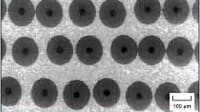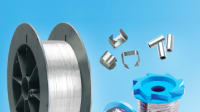Modifications of BN-based coatings that are used as interfacial layers between the fibers and matrices of SiC-fiber/SiC-matrix composite materials have been investigated to improve the thermomechanical properties of these materials. Such interfacial coating layers, which are also known as interphases (not to be confused with "interphase" in the biological sense), contribute to strength and fracture toughness of a fiber/matrix composite material by providing for limited amounts of fiber/matrix debonding and sliding to absorb some of the energy that would otherwise contribute to the propagation of cracks.

Heretofore, the debonding and sliding have been of a type called "inside debonding" because they have taken place predom- inantly on the inside surfaces of the BN layers — that is,at the interfaces between the SiC fibers and the interphases. The modifications cause the debonding and sliding to include more of a type, called "outside debonding," that takes place at the outside surfaces of the BN layers — that is, at the interfaces between the interphases and the matrix (see figure).
One of the expected advantages of outside debonding is that unlike in inside debonding, the interphases would remain on the crack-bridging fibers. The interphases thus remaining should afford additional protection against oxidation at high temperature and should delay undesired fiber/fiber fusion and embrittlement of the composite material. A secondary benefit of outside debonding is that the interphase/matrix interfaces could be made more compliant than are the fiber/interphase interfaces, which necessarily incorporate the roughness of the SiC fibers. By properly engineering BN interphase layers to favor outside debonding, it should be possible, not only to delay embrittlement at intermediate temperatures, but also to reduce the effective interfacial shear strength and increase the failure strain and toughness of the composite material.
Two techniques have been proposed and partially experimentally verified as candidate means to promote outside debonding in state-of-the-art SiC/SiC composites. The first technique is one of application of a weak layer (for example, a layer of C) to the outer surface of the BN interphase. If residual radial tension exists across the interphase (caused, for example, by a thermal-expansion mismatch between the fiber and matrix), then outside debonding could occur during cool down of the composite from its matrix-processing temperature (typically >1,000 °C)to room temperature. If the residual tension is not great enough, outside debonding should nevertheless occur as matrix cracks approach the fibers under some stress conditions.
The second technique for promoting outside debonding is one of heat treatment of the composite at a temperature above that normally used for processing the matrix. During the heat treatment, the BN interphase, which is typically formed in a porous state at temperatures below 1,000 °C, becomes densified by sintering, so that the interphase contracts away from the SiC matrix. This contraction may cause a gap to form between the BN interphase and SiC matrix, or, at the very least, increase the residual radial tension at the BN/matrix interface.
In stress-rupture tests in air at a temperature of 800 °C, the 100-hour failure stress of state-of-the-art SiC/SiC composite modified to promote outside debonding was as much as 50 percent greater than that of the corresponding unmodified (inside debonding only) composite. The room-temperature strain to failure of the outside-debonding composite was found to be 0.5 percent, as compared with 0.4 percent for the inside-debonding composite, and the ultimate tensile strength of the outside-debonding composite was not less than that of the inside-debonding composite.
This work was done by Gregory N. Morscher, Ramakrishna Bhatt, Hee-Mann Yun, and James A. DiCarlo of Glenn Research Center.
Inquiries concerning rights for the commercial use of this invention should be addressed to:
NASA Glenn Research Center
Commercial Technology Office
Attn: Steve Fedor
Mail Stop 4-8
21000 Brookpark Road
Cleveland, Ohio 44135
Refer to LEW-17240-1.






















